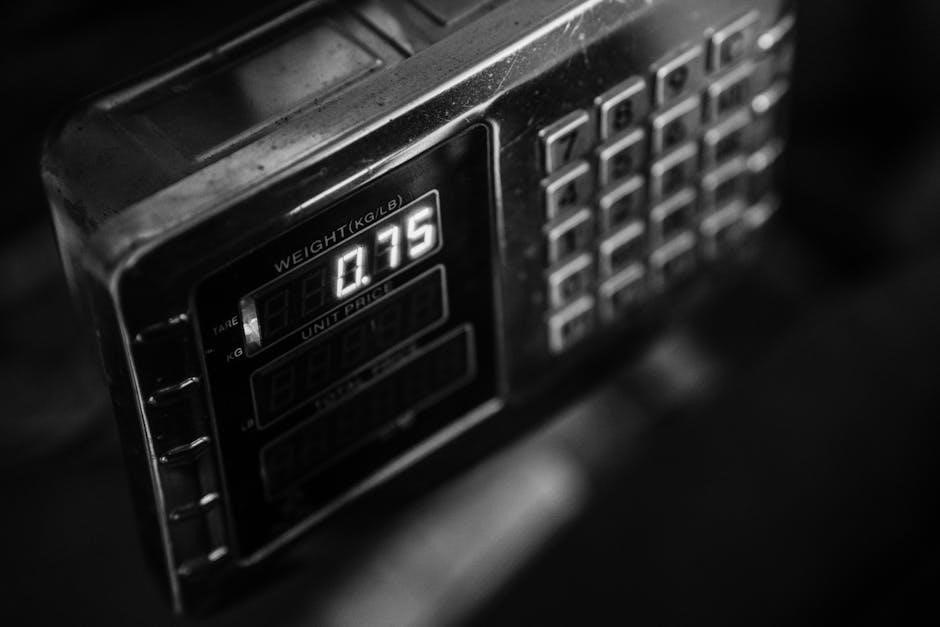Carl Flesch’s Scale System is a foundational method for violinists, offering exercises in all major and minor keys․ It serves as a supplement to his seminal work, The Art of Violin Playing, and is renowned for its structured approach to improving intonation, technique, and musicality․ Revised by Max Rostal, the system remains a cornerstone in violin pedagogy, with a downloadable PDF version available for modern students․
Overview of the Scale System
Carl Flesch’s Scale System is a comprehensive method designed for daily study, offering exercises in all major and minor keys․ Organized systematically, it includes scales, arpeggios, and broken chords, progressing through the circle of fifths․ Each key features twelve exercises, alternating between major and relative minor, with a focus on improving intonation, technical facility, and musicality․ The system is structured to address both fundamental and advanced techniques, making it accessible to violinists at various skill levels․ Available as a PDF download, the revised edition incorporates modern pedagogical insights while maintaining Flesch’s original principles, ensuring its relevance for contemporary violin education and practice․
Significance of the Scale System in Violin Pedagogy
Carl Flesch’s Scale System holds a revered place in violin pedagogy as a cornerstone for technical and musical development․ Its comprehensive structure, covering all major and minor keys, provides a thorough framework for improving intonation, facility, and expressive playing․ The system’s exercises, including scales, arpeggios, and broken chords, are designed to address both foundational and advanced techniques, making it invaluable for violinists of all levels․ As a supplement to Flesch’s The Art of Violin Playing, the Scale System has been adapted and revised to meet modern pedagogical demands, ensuring its relevance in contemporary violin education․ Its availability as a downloadable PDF further enhances its accessibility for today’s students and educators․

Background of Carl Flesch
Carl Flesch, born in 1873, was a renowned Hungarian violinist and pedagogue․ He owned the Brancaccio Stradivarius but sold it after financial losses․ His teachings significantly influenced violin education․
Early Life and Career of Carl Flesch
Carl Flesch, born in 1873, was a Hungarian violinist and educator of significant influence․ He began his musical journey as a child prodigy, quickly gaining recognition for his technical prowess․ Flesch’s career spanned multiple countries, including Hungary, Germany, and England․ He was known for owning the prestigious Brancaccio Stradivarius but faced financial hardships, leading to its sale in 1928․ During the 1930s, he lived in London and later faced challenges when arrested by the Gestapo in 1939, though he was eventually released․ Flesch’s life ended in 1944 in Lucerne, Switzerland, leaving behind a legacy in violin pedagogy․
Flesch’s Contributions to Violin Teaching
Carl Flesch revolutionized violin pedagogy through his Scale System, a comprehensive method for technical and musical development․ His approach emphasized systematic practice, focusing on intonation, facility, and expressive playing; Flesch’s Scale System, available as a PDF, includes exercises in all major and minor keys, structured to build proficiency gradually․ Beyond his Scale System, Flesch authored The Art of Violin Playing, a two-volume treatise that remains influential․ His teachings have shaped generations of violinists, offering a balanced approach to technique and artistry․ Flesch’s legacy endures as a cornerstone of violin education, with his methods continuing to inspire and guide students and teachers worldwide;

Structure of the Scale System
Carl Flesch’s Scale System is organized into exercises covering all major and minor keys, designed for daily study to enhance technical facility and intonation accuracy․
Organization of Scales and Exercises
The system is meticulously organized, with scales and exercises arranged progressively․ Each key is explored in depth, alternating between major and minor, following the circle of fifths․ This structured approach ensures a comprehensive understanding of tonalities, facilitating smooth transitions between keys․ The exercises are designed to improve both intonation and technical dexterity, with specific patterns targeting common challenges․ By systematically covering all keys, the system provides a robust foundation for violinists, enabling them to master a wide range of musical demands with precision and confidence․
Key Arrangements and Progressions
Carl Flesch’s Scale System is arranged to cover all major and minor keys, progressing through the circle of fifths․ This logical sequence ensures a deep understanding of tonal relationships․ Each key is paired with its relative minor, allowing for a seamless transition between major and minor modes․ The system alternates between ascending in flats and descending in sharps, providing a balanced approach to key progression․ This methodical arrangement helps violinists build technical facility and tonal awareness, while the structured progressions facilitate mastery of complex key relationships․ The system’s clarity and organization make it an invaluable resource for developing musicians․
Technical Exercises and Their Purpose
Carl Flesch’s Scale System includes technical exercises designed to enhance intonation, dexterity, and accuracy․ These exercises are structured to address specific challenges, such as finger placement, bow control, and shifting․ By practicing scales and arpeggios in all major and minor keys, violinists develop a strong technical foundation․ The exercises are progressive, increasing in difficulty to match the advancing skill level of the player․ Flesch’s system emphasizes the importance of precise fingerings and bowings, ensuring that students master the physical aspects of playing․ This focus on technical proficiency allows musicians to execute complex repertoire with confidence and precision, making the system indispensable for violinists seeking to refine their craft․

Benefits of the Scale System
Carl Flesch’s Scale System improves intonation, technical facility, and musicality through structured exercises․ It enhances precision, dexterity, and consistency, providing a comprehensive foundation for violinists to refine their skills effectively․
Improving Intonation and Pitch Accuracy
Carl Flesch’s Scale System is renowned for its ability to enhance intonation and pitch accuracy through structured exercises․ By practicing scales in all major and minor keys, violinists develop a keen sense of pitch and precise finger placement; The system’s organized approach ensures consistent improvement, as each exercise is designed to target specific intervals and tonal relationships․ Over time, this method cultivates a strong musical ear and reduces intonation errors, allowing players to perform with greater confidence and accuracy․ The repetitive nature of the exercises also reinforces proper technique, further solidifying intonation skills and laying a foundation for advanced repertoire․
Developing Technical Facility
Carl Flesch’s Scale System is instrumental in developing technical facility by providing a comprehensive series of exercises․ These exercises are designed to enhance finger dexterity, bow control, and overall coordination․ By practicing scales in all major and minor keys, violinists improve their ability to navigate the fingerboard with precision․ The system’s structured progression ensures that technical challenges are addressed systematically, fostering mastery of complex passages․ Regular practice of these exercises strengthens left-hand technique, including finger independence and intonation accuracy․ Additionally, the exercises promote bow arm agility and tone production, enabling violinists to tackle demanding repertoire with confidence and technical proficiency․
Cultivating Musicality Through Scales
Carl Flesch’s Scale System not only enhances technical skill but also serves as a tool for cultivating musicality․ The exercises encourage violinists to explore phrasing, dynamics, and articulation within a structured framework․ By practicing scales with attention to tone quality and expressive nuances, players develop a deeper connection to the music․ Flesch’s system emphasizes the importance of musical expression, transforming scales from mere technical drills into vehicles for artistic interpretation․ This approach helps violinists to understand the relationship between technique and musicality, fostering a well-rounded and expressive performance style that goes beyond mere technical proficiency․

Practical Applications of the Scale System
The Carl Flesch Scale System is widely used for daily practice, audition preparation, and addressing technical challenges․ Its structured exercises enhance intonation, facility, and musical expression, making it indispensable for violinists․
Daily Practice Routine Recommendations
Implementing the Carl Flesch Scale System into a daily routine is essential for consistent progress․ Violinists should begin with scales in major and minor keys, focusing on intonation and bow control․ Start with slower tempos to ensure accuracy, gradually increasing speed as proficiency grows․ Allocate 20-30 minutes daily to scales, incorporating arpeggios and chromatic exercises for a comprehensive workout․ Prioritize scales in all keys to build familiarity and dexterity․ Regular practice reinforces technical skills, while mindful attention to dynamics and articulation enhances musicality․ A structured approach ensures balanced development, making the Flesch system a valuable tool for aspiring and advanced violinists alike․
Addressing Common Technical Challenges
The Carl Flesch Scale System is designed to tackle common technical challenges faced by violinists․ Intonation issues can be addressed through targeted exercises in all keys, ensuring familiarity with pitch relationships․ Bow control and articulation are refined via arpeggios and chromatic scales, which demand precise finger placement and stroke consistency․ For left-hand dexterity, the system’s progressive structure builds finger strength and agility․ Students often struggle with intonation in higher positions, but Flesch’s methodical approach to scales in octaves and multiple stops helps master these areas․ By systematically practicing these exercises, violinists can overcome technical hurdles and achieve a polished, professional sound․
Using the System for Audition Preparation
Carl Flesch’s Scale System is invaluable for audition preparation, offering a comprehensive framework to refine technical and musical skills․ The exercises in all major and minor keys ensure mastery of scales, arpeggios, and chromatic patterns, which are often audition requirements․ The system’s focus on intonation, tone production, and facility helps violinists deliver polished performances․ By practicing Flesch’s method, students can build confidence and consistency, essential for auditions․ Additionally, the PDF format allows for easy access, enabling thorough preparation․ Many professional violinists attribute their audition success to Flesch’s system, making it a trusted resource for aspiring musicians aiming to impress judges with technical precision and artistic expression․

Historical Context and Influence
Carl Flesch’s Scale System, first published decades ago, revolutionized violin pedagogy with its systematic approach to technical mastery․ Updated editions ensure relevance, making it a cornerstone of violin education․
Impact on Violin Pedagogy
Carl Flesch’s Scale System has profoundly influenced violin pedagogy by providing a comprehensive framework for technical development․ Its structured exercises in all major and minor keys ensure consistent improvement in intonation and facility․ The system’s emphasis on daily practice has set a standard for disciplined study, fostering musicality and precision․ Many prominent violin educators have adopted Flesch’s methods, integrating his scale exercises into their teaching․ This approach remains indispensable, shaping generations of violinists and solidifying its place as a foundational resource in violin education․
Notable Violinists Influenced by Flesch’s System
Carl Flesch’s Scale System has shaped the techniques of numerous renowned violinists․ One such artist is Max Rostal, a pupil of Flesch, who later revised the Scale System, ensuring its continued relevance․ The system’s structured approach also influenced Yehudi Menuhin, who valued its technical and musical depth․ Additionally, virtuosos like Henryk Szeryng and Nathan Milstein credited Flesch’s method with enhancing their intonation and facility․ These violinists, among many others, exemplify how Flesch’s work has nurtured excellence, leaving a lasting legacy in the world of violin performance․

Comparison with Other Scale Systems
Carl Flesch’s Scale System is distinguished by its comprehensive structure and unique features, such as exercises in all keys and detailed fingerings, setting it apart from other methods․
Unique Features of Flesch’s Approach
Carl Flesch’s Scale System stands out for its comprehensive structure and innovative exercises․ It includes scales and arpeggios in all major and minor keys, providing a holistic approach to technical development․ Flesch’s method emphasizes detailed fingerings and bowings, ensuring clarity and precision․ The system progresses logically, with exercises arranged to address specific technical challenges․ Additionally, Flesch integrates musicality into scales, encouraging expressive playing․ Unlike other systems, it offers a balance between intonation, facility, and artistry, making it a versatile tool for violinists․ The availability of the PDF version ensures accessibility for modern students, maintaining its relevance in contemporary violin pedagogy․
Contrast with Other Prominent Scale Methods
Carl Flesch’s Scale System differs from other methods by its comprehensive approach and integration of musicality․ While systems like Galamian’s focus heavily on technical rigor, Flesch’s method balances technique with expressive playing․ His use of detailed fingerings and bowings provides clarity, unlike more generalized approaches․ Additionally, Flesch’s systematic progression through all major and minor keys offers a structured path for development․ In contrast to Doflein’s folk-oriented method, Flesch’s system is universally applicable, emphasizing both intonation and artistry․ This balanced approach sets it apart, making it a versatile tool for violinists seeking to refine technique and musical expression simultaneously․

Legacy of Carl Flesch’s Work
Carl Flesch’s Scale System remains a cornerstone of violin pedagogy, influencing generations of violinists․ His work continues to be celebrated for its enduring relevance and adaptability, ensuring his legacy endures․
Enduring Popularity of the Scale System
Carl Flesch’s Scale System has maintained its popularity due to its comprehensive structure and adaptability․ The system, available as a downloadable PDF, provides exercises in all major and minor keys, making it a versatile tool for violinists․ Its focus on improving intonation, technique, and musicality continues to resonate with both students and professionals․ The revised edition by Max Rostal has further enhanced its accessibility, ensuring its relevance in modern violin pedagogy․ The system’s enduring appeal lies in its ability to cater to the needs of advancing players, solidifying its place as a timeless resource in violin education․
Flesch’s Other Contributions to Violin Literature
Beyond his renowned Scale System, Carl Flesch made significant contributions to violin literature through his writings and performances․ His book, The Art of Violin Playing, remains a seminal work, offering deep insights into technique, interpretation, and musical expression․ Flesch was also a skilled performer, having owned the prestigious Brancaccio Stradivarius before financial setbacks forced its sale․ His work as a pedagogue and author has left a lasting legacy, influencing generations of violinists․ Flesch’s contributions extend beyond scales, shaping the understanding and practice of violin playing worldwide․

Digital Availability and Access
Carl Flesch’s Scale System is widely available as a PDF download, offering convenient access to its comprehensive exercises․ Digital formats enhance study with portability and search features․
Downloading the Carl Flesch Scale System PDF
The Carl Flesch Scale System PDF is a widely recognized resource for violinists, offering a comprehensive collection of scale exercises in all major and minor keys․ Available for download from various music repositories and educational platforms, the PDF provides a structured approach to improving technical skills and intonation․ Originally published decades ago, the system has been revised and updated to meet modern pedagogical standards․ The digital format ensures easy access and portability, allowing violinists to practice anywhere․ The PDF includes detailed fingerings and exercises designed to enhance facility and musicality․ It remains a staple in violin education, admired for its clarity and effectiveness․
Advantages of the Digital Format
The digital format of Carl Flesch’s Scale System offers unparalleled convenience and accessibility․ As a downloadable PDF, it eliminates the need for physical storage, allowing violinists to access exercises anytime, anywhere․ The digital version is easily shareable between teachers and students, facilitating collaborative learning․ Annotations and bookmarks can be added to highlight key exercises, enhancing practice efficiency․ Additionally, the PDF format ensures that the content remains crisp and legible, even on small screens․ This modern accessibility makes Flesch’s timeless method more approachable for contemporary musicians, blending tradition with technological advancements to support effective practice and musical growth․

Testimonials and Reviews
The Carl Flesch Scale System PDF has garnered widespread acclaim from professional violinists and educators, who praise its structured approach and effectiveness in improving technique․
Professional Endorsements
Carl Flesch’s Scale System has earned high praise from renowned violinists and educators․ Many professionals acclaim it as a staple in violin pedagogy, emphasizing its structured approach to improving technique and musicality․ Violinists who have benefited from the system highlight its effectiveness in developing intonation, facility, and articulation․ Educators often recommend it as a foundational tool for students and advanced players alike․ Its inclusion of exercises in all major and minor keys ensures comprehensive skill development․ The system’s enduring popularity is a testament to its value in the violin community, making it a trusted resource for achieving mastery․ Professionals worldwide endorse it as an essential part of violin training․
Student and Teacher Feedback
Students and teachers worldwide have praised Carl Flesch’s Scale System for its comprehensive and methodical approach to violin training․ Many students appreciate the clear structure and the progressive difficulty of the exercises, which help build technical facility and intonation․ Teachers often highlight the system’s ability to address specific challenges, such as intonation accuracy and articulation․ While some students find the exercises demanding, they consistently report significant improvement in their playing․ The system’s focus on all major and minor keys ensures a well-rounded musical development․ Both students and educators agree that Flesch’s Scale System remains an indispensable tool for violinists seeking to master their craft․
Carl Flesch’s Scale System remains a timeless and invaluable resource for violinists, offering a comprehensive approach to technical mastery and musical expression․ Its enduring popularity underscores its significance in violin pedagogy, making it an essential tool for aspiring musicians․
Final Thoughts on the Scale System
Carl Flesch’s Scale System stands as a testament to his profound impact on violin pedagogy․ Its structured approach to scales and exercises ensures comprehensive technical development․ The system’s emphasis on intonation, facility, and musicality makes it indispensable for violinists at all levels․ The availability of the PDF version has made it accessible to a global audience, ensuring its relevance in modern musical education․ By integrating Flesch’s method into daily practice, violinists can achieve a higher level of artistry and precision, fulfilling the system’s purpose as a cornerstone of violin training․
Encouragement for Aspiring Violinists
Aspiring violinists are encouraged to embrace Carl Flesch’s Scale System as a vital tool for growth․ This comprehensive method, available as a downloadable PDF, provides a structured path to mastering scales and technical proficiency․ By dedicating time to these exercises, players can enhance their intonation, dexterity, and musical expression․ The system’s progressive approach ensures steady improvement, making it suitable for both beginners and advanced musicians․ Flesch’s legacy offers inspiration, reminding violinists that consistent practice and a commitment to his methods can lead to artistic excellence and a deeper connection to the music they create․
